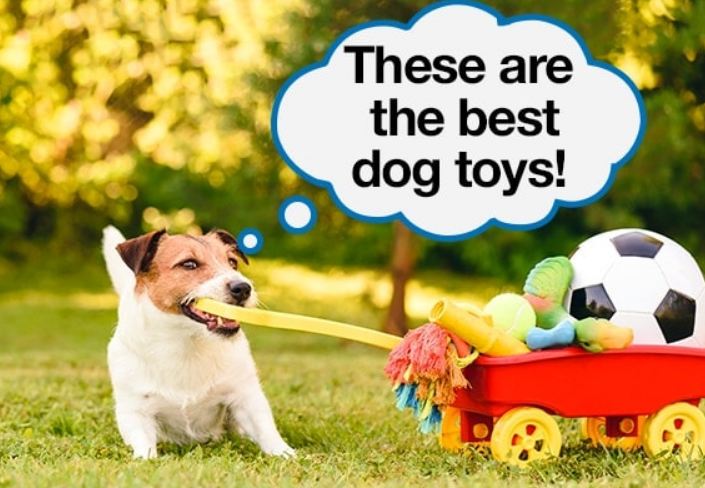
How to choose the right toys for your dog – One of the best things about being a pet parent of a dog is that they love to play, and choosing the best dog toys is an important part of your relationship. Whether you’re playing fetch or watching him roll around for fun, toys are an important part of your dog’s health. What to consider when choosing the best?

Age : While he won’t be as mature as you, you should still keep your dog’s age in mind. A three-week-old puppy still has baby teeth, so softer rubber toys or snug fabric toys will work well for him. Between three and nine months old, your puppy will be teething, so it’s best to avoid hard rubber and be sure to stock up! He’ll chew on anything he can get his hands on with his claws, so a selection of chew toys will distract him from your favorite slippers.
After the teething period is over, your dog will have jaws strong enough to play balls or pulleys with harder rubber toys and endless energy. By around age 7, your older dog won’t have the jaw and teeth strength of a younger adult, but it’s still important to give him softer toys to chew and play with that encourage him to stay active throwing balls and sticks. Fortunately, there are many options specifically for dogs of specific ages, all tailored to your dog’s age, size and personal chewing habits.
Size and texture : Even as an adult dog, petite Yorkshire Terriers are less likely to chew like larger German Shepherds, so they often need toys that are considered more forgiving when clenching their smaller jaws. Likewise, toys that are too soft can shatter into pieces and cause choking or choking, which can lead to gastrointestinal obstruction. If you notice signs of damage to the toy—such as a damaged squeak, or a crack or tear in the fabric or padding—it’s usually best to replace it.
Proper toy size is also important. Too small things are also easy to swallow. The general rule is to make sure anything small enough to fit behind your dog’s back molars is a choking hazard.
Ultimately, it’s up to you to decide which type of toy will best keep your companions busy. Dogs, like humans, can designate their favorite toys over time.
Type of toy: Even with this information in hand, navigating the toy aisle can still be a little confusing. When shopping, consider these four toy options based on your individual dog’s needs and you’ll be well on your way to finding the perfect toy.
Ball: There are rubber balls, plush balls, tennis balls, foam balls, squeaky balls, and more. Everyone dances differently. Some float and glow in the dark if you have a pool or nocturnal activity – tempting option! This classic option is also a great way to keep your dog active. When you find the right size ball for your dog, make sure it’s made of durable enough material so he doesn’t chew it into small pieces. Balls also encourages you to get involved as a parent, as dogs love grab or catch games. This will also help strengthen your bond over time.
Tug toy: Most dogs enjoy playing tug-of-war with their owners and other dogs. Although there are some caveats to this play to avoid aggression, PAWS recommends that if your puppy is properly trained, there is nothing to worry about. Probably the most important thing to remember about dragging a toy is to make sure your dog doesn’t tear it to shreds. Tug toys are usually plush toys, made of linen, leather, fire hose, or rope, so they must be replaced as soon as any damage is found (such as chopped or missing parts). It’s also worth noting that you don’t get too aggressive yourself when playing tug of war. You never want to rip a toy out of your dog’s mouth as it could cause him serious health problems. If you want him to let go of the toy, you need to teach him to respond to commands like “drop it” or “let go.” Even if a dog has a very strong jaw, it is never a good idea to pull the toy vertically and lift its feet off the ground. This can cause problems with the jaw, neck and spine.
Snacks and Chews: While anything can be a chew toy, some toys are specifically designed to be chewed, and it’s best to use them for this purpose. These items are usually made of nylon or hard rubber material for durability. Some can even be filled with snacks for workouts and long-lasting entertainment, while others can be indulgent. They should be soft enough to chew without breaking your teeth, but firm enough so they don’t break into small pieces easily. However, as your dog grows from puppy to adult, you will often find that you need to change the size and durability of the chew toys you bring home. Just be sure to include healthy snacks in your toys to keep them extra healthy while staying active!
Luxurious: Plush toys are a favorite of many dogs, but unfortunately they are mostly unsafe. Although soft toys are easy to shred and swallow, they can still be fun when fully supervised. Plush toys are also a great option for snuggling at night, before your pup gets into the teething stage. If your dog loves them, don’t write them down right away. Just make sure your puppy knows which plush toy is theirs, not a family member’s plush or pillow.
